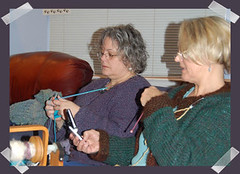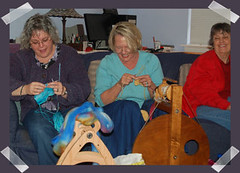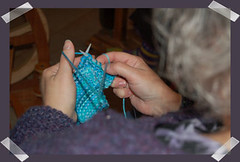I found instructions for dyeing the lint and also for dyeing cotton sliver at the Cotton Spinning Website.
Joan Ruane runs this site, and she is an expert cotton spinner. She has instructions for dyeing the lint or sliver with both the MX Dyes and also with Natural Dyes on her website and she also has a DVD on how to spin cotton that is available there.
I sort of combined Joan's instructions on dyeing lint with her instructions on dyeing sliver, as I wanted multi-colored lint to spin rather than a solid color.
Here is what I did:
- Scour the Cotton - put a pot on the burner and fill it about 3/4 full of water. Add a little dish soap. Break up the lint and immerse it in the water, forcing it under. Bring the pot to a simmer and let it simmer for 15-30 minutes or so. A lot of dirt will come out.
- Rinse the Cotton and squeeze out most of the water.
- Soak the wet lint in Salt water for 10 minutes - Here I switched to the instructions for dyeing cotton sliver. I used Joan's instructions of 1/2 cup of salt dissolved in one gallon of water and let my lint soak while I mixed my dyes and activator solution.
- Mix dyes - I used Joan's recommendation of 1/4 tsp of dye powder to about 3/8 cup of water. I mixed the colors I wanted - a green, a purple, turquoise and navy blue in separate bottles.
 Prepare soda ash solution to activate the dye - I mixed in another container 1/4 cup of soda ash to 3/4 cup of hot water. This should be enough soda ash solution for 6 colors of dye stock, so I was good with my 4 colors
Prepare soda ash solution to activate the dye - I mixed in another container 1/4 cup of soda ash to 3/4 cup of hot water. This should be enough soda ash solution for 6 colors of dye stock, so I was good with my 4 colors- Squeeze out wet lint and put it on plastic sheet - at this point I took the wet cotton lint from the salt water solution and squeezed it with my hands until it was fairly dry. I lined my concrete mixing tub (a useful Home Depot or Lowe's item) with a few sheets of newspaper and a large sheet of clear plastic from a partial roll my friend Laurie gave me. A garbage bag or a couple of sheets of saran would work. I then spread out the wet lint on the plastic in the tub.
- Add activator to dye and apply - One at a time I added 1/8 cup or 1 ounce of activator to each dye. Then I applied that color at random on the lint until it was gone. The activator needs to be added to the dye, then the dye needs to be used quickly. I have read that after 45 minutes, it is technically exhausted or has lost a lot of potency.
- Wrap the dyed fiber and leave in a warm place for the dye to work - Unlike the acid dyes, the MX dyes work at warm room temperature and do not like to get too hot. It was a fairly cool day so, I put my plexiglass cover on the concrete container with the wrapped dyed fiber and left it in the sun for a couple of hours. Then I left the dyed fiber alone until the next day before I began rinsing.
- Rinse and rinse and rinse - Here is something that I find frustrating about the MX dyes - all the rinsing required. I have found that the item or yarn or fiber needs about 10 rinses in cool water before the water is semi-clear. I rinsed out the fiber
- Scour the rinsed fiber and set the color - Next I put the fiber back in the pot of water with some Dawn and brought it up to a simmer for another 30 minutes to set the color.

- Rinse out the soap, squeeze the fiber out - I had the bright idea to put the dyed lint in my front loader and spin it out. I put it in a mesh bag, but the heavy cotton that was full of water made the machine very unhappy. Next time I do this, I will remember to split it over several bags.
- Dry the fiber - I put dyed lint in a mesh bag and gave it a dryer cycle which left it pretty wet still. Then, I let it dry over night and gave it another dryer cycle and it was slightly damp, so I put it in a mesh hamper that would let the air get to it and hung it to dry another day.
- Tease, card and spin - I have started making punis from the fiber. It is going to be so much fun to spin my colored cotton!
 Here is my pile of cotton fiber with some of the punis I have made so far. I will probably card all of it before I start spinning.
Here is my pile of cotton fiber with some of the punis I have made so far. I will probably card all of it before I start spinning.
I am still not as comfortable with the MX dyes as with acid dyes on wool. This session helped some, but I guess I need more practice. Fortunately I have another pound and a half of cotton lint.
Now, I want to get out the bamboo roving I have and try dyeing that!





 After lunch we had our "workshops." Marlene bought her
After lunch we had our "workshops." Marlene bought her  Laurie and Joanne tried it out while the rest of us kept spinning. There were some fits and starts. Joanne thought she was doing the knit stitch, but it turned our she had learned the purl stitch. There was lots of laughing about this.
Laurie and Joanne tried it out while the rest of us kept spinning. There were some fits and starts. Joanne thought she was doing the knit stitch, but it turned our she had learned the purl stitch. There was lots of laughing about this.  After everyone left, I searched YouTube for
After everyone left, I searched YouTube for 